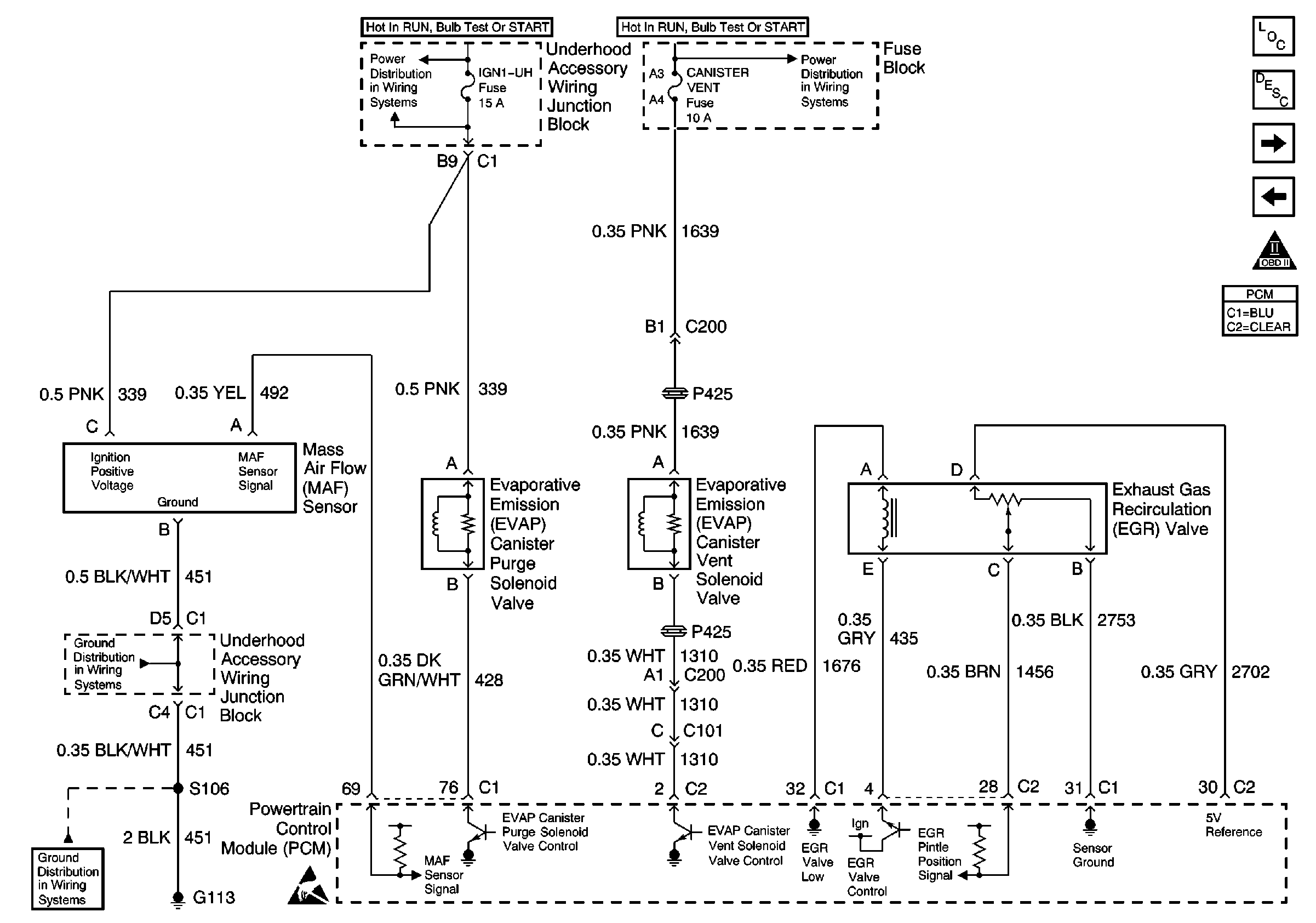Refer to Engine Controls Schematics,
MAF, EVAP Purge, EVAP Canister, EGR Valve

Circuit Description
Output driver modules (ODMs) are used by the PCM in order to turn on many of the current-driven devices that are needed to control various engine and the transmission functions. Each ODM is capable of controlling up to 7 separate outputs by applying ground to the device which the PCM is commanding ON. Unlike the quad driver modules (QDMs) used in prior model years, the ODMs are capable of diagnosing each output circuit individually. DTC P0443 set indicates an improper voltage level has been detected on the output circuit which controls the EVAP canister purge solenoid valve.
Conditions for Running the DTC
The ignition is ON.
Conditions for Setting the DTC
| • | An improper voltage level is detected on the output circuit which controls the EVAP canister purge solenoid valve. |
| • | The above condition is present for at least 30 seconds. |
Action Taken When the DTC Sets
| • | The PCM will illuminate the MIL during the second consecutive trip in which the diagnostic test has run and failed. |
| • | The PCM will store conditions which were present when the DTC set as Freeze Frame and Failure Records data. |
Conditions for Clearing the MIL/DTC
| • | The PCM will turn the MIL OFF during the third consecutive trip in which the diagnostic has run and passed. |
| • | The history DTC will clear after 40 consecutive warm-up cycles have occurred without a malfunction. |
| • | Clear the DTC by using the scan tool Clear Information function, or by disconnecting the PCM battery feed. |
Diagnostic Aids
Check for the following conditions:
| • | A poor connection at the PCM--Inspect the harness connectors for the following conditions: |
| - | Backed-out terminals |
| - | Improper mating |
| - | Broken locks |
| - | Improperly-formed terminals |
| - | Damaged terminals |
| - | Poor terminal-to-wire connections |
| • | A damaged harness--Inspect the wiring harness for damage. If the harness appears OK, disconnect the PCM, turn ON the ignition, and observe a voltmeter connected between the solenoid control circuit and ground at the PCM harness connector while moving connectors and wiring harnesses that are related to the solenoid. A change in voltage will indicate the location of the malfunction. |
Review the Failure Records vehicle mileage since the diagnostic test last failed. This procedure may help to determine how often the condition that caused the DTC to be set occurs.
Test Description
The numbers below refer to the step numbers on the diagnostic table.
-
The powertrain OBD System Check prompts you to complete some basic checks and to store the freeze frame and failure records data on the scan tool.
-
Listen for clicking when the purge solenoid operates. Command both the Increase and the decrease states. Repeat the commands as necessary.
-
This step tests for voltage at the feed side of the solenoid.
-
This step verifies that the PCM is providing ground to the solenoid.
-
This step tests if ground is constantly being applied to the solenoid.
-
The PCM utilizes an electrically erasable programmable read-only memory (EEPROM). When you replace the PCM, you must program the new PCM.
Step | Action | Values | Yes | No |
|---|---|---|---|---|
Did you perform the Powertrain On-Board Diagnostic (OBD) System Check? | -- | Go to Step 2 | ||
Does the solenoid respond with each command? | -- | Go to Diagnostic Aids | Go to Step 3 | |
Does the test lamp illuminate? | -- | Go to Step 4 | Go to Step 10 | |
Does the test lamp turn ON and OFF with each command? | -- | Go to Step 8 | Go to Step 5 | |
Does the test lamp remain illuminated with each command? | -- | Go to Step 7 | Go to Step 6 | |
6 | Test the control circuit of the solenoid for a short to voltage or for an open. Refer to Wiring Repairs in Wiring Systems. Did you find and correct the condition? | -- | Go to Step 13 | Go to Step 9 |
7 | Test the control circuit of the solenoid for a short to ground. Refer to Wiring Repairs in Wiring Systems. Did you find and correct the condition? | -- | Go to Step 13 | Go to Step 9 |
8 | Inspect for poor connections at the solenoid. Refer to Testing for Intermittent Conditions and Poor Connections and Connector Repairs in Wiring Systems. Did you find and correct the condition? | -- | Go to Step 13 | Go to Step 11 |
9 | Inspect for poor connections at the PCM. Refer to Testing for Intermittent Conditions and Poor Connections and Connector Repairs in Wiring Systems. Did you find and correct the condition? | -- | Go to Step 13 | Go to Step 12 |
10 | Repair the feed circuit of the solenoid. Refer to Wiring Repairs in Wiring Systems. Did you complete the repair? | -- | Go to Step 13 | -- |
11 | Replace the solenoid. Refer to Evaporative Emission Canister Purge Solenoid Valve Replacement . Did you complete the replacement? | -- | Go to Step 13 | -- |
|
Important: Perform the setup procedure for the PCM. Replace the PCM. Refer to Powertrain Control Module Replacement/Programming . Did you complete the replacement? | -- | Go to Step 13 | -- | |
13 |
Does the DTC reset? | -- | Go to Step 2 | System OK |
